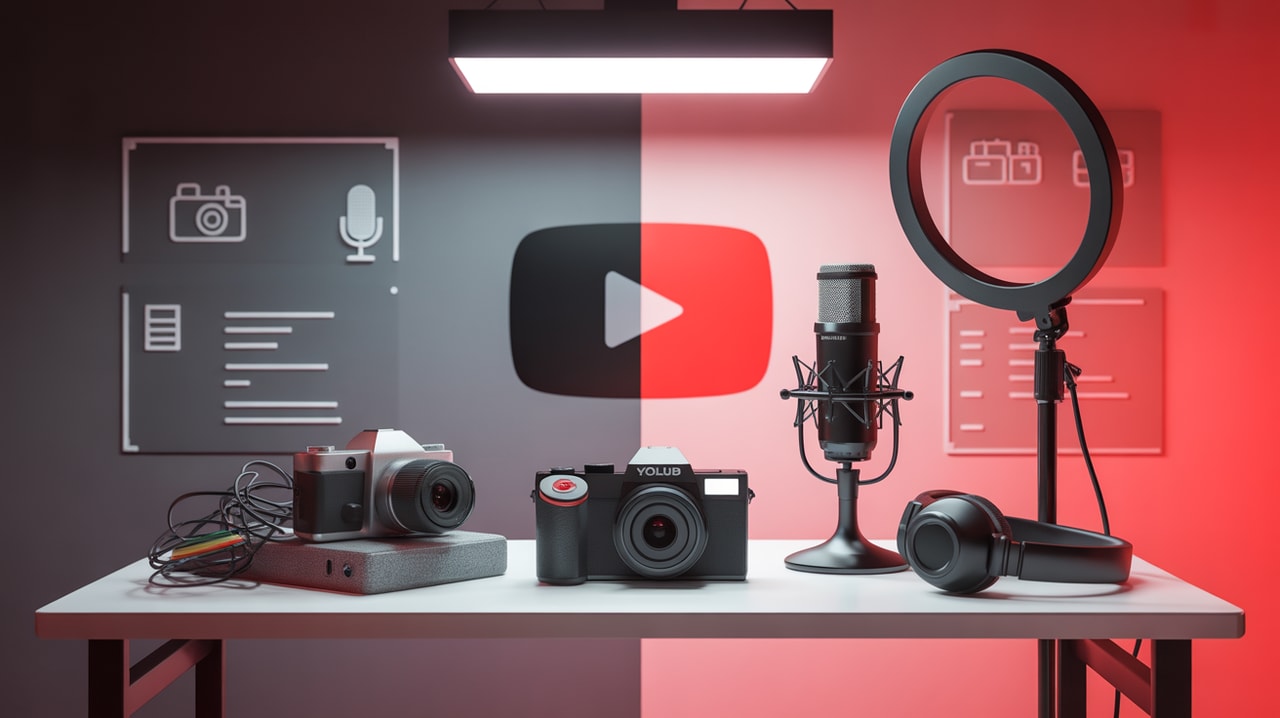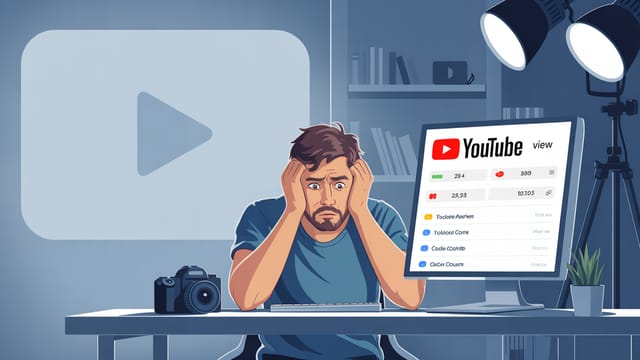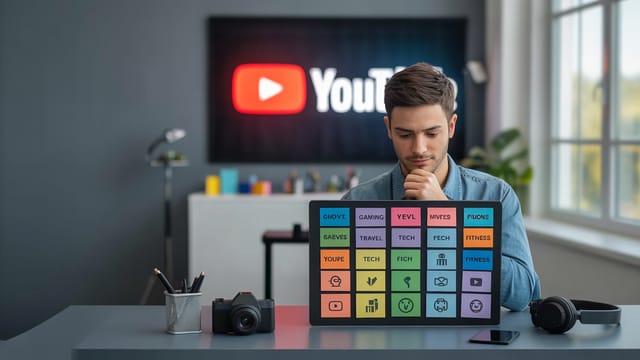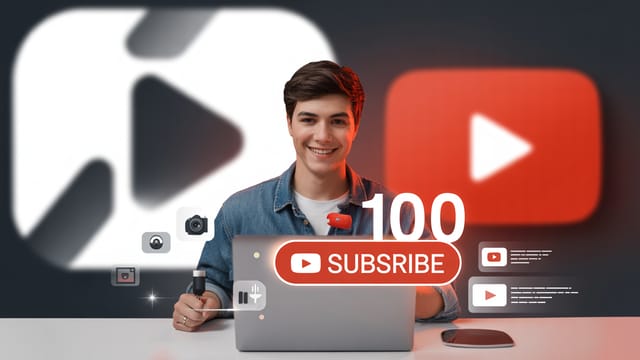
Ready to get your next 10,000 subscribers?
Join thousands of creators who use Subscribr to create faster, better YouTube videos.
As a growth-focused YouTube creator, you're constantly looking for ways to improve your content and reach a wider audience. You pour hours into ideation, scripting, filming, and editing. But sometimes, you hit a plateau. You might look at successful channels and wonder, "Is my equipment the problem?"
The uncertainty about when and what to upgrade can be a major headache. With endless reviews and new gear constantly hitting the market, it's easy to fall into analysis paralysis or simply buy expensive equipment you don't actually need.
This article provides a comprehensive checklist to help you evaluate your current YouTube gear setup and determine if it's truly a bottleneck in your growth. We'll cut through the noise and help you identify the upgrades that will give you the most meaningful impact.
Why Upgrade Your YouTube Gear? (Beyond Just "Better Quality")
Before we dive into the checklist, let's be clear: upgrading your gear isn't just about getting prettier footage. While improved quality is a benefit, the real value often lies elsewhere. According to experts in YouTube strategy, upgrading your video gear can:
- Speed up your workflow and save time: Time is one of your most valuable assets as a creator. Gear that makes filming, transferring footage, editing, or exporting faster means more time for creating content or focusing on strategy.
- Elevate your brand: The visual and audio quality of your videos is a direct reflection of your brand. Professional-looking and sounding videos build trust and make you appear more credible and serious, which can be crucial for attracting subscribers and potential brand deals.
- Enhance the viewer experience: Ultimately, your audience's experience is paramount. Better audio, clearer video, and smoother editing create a more enjoyable viewing experience, which can lead to higher retention and engagement.
- Empower your storytelling: Sometimes, better gear provides the tools you need to tell your story more effectively. Different lenses can create specific looks, improved lighting sets the mood, and a reliable camera ensures you don't miss crucial moments.
- Help you make more money (directly or indirectly): While not the primary goal for everyone, better gear can open up opportunities for freelance work or indirectly increase revenue through improved monetization and brand partnerships due to higher quality content.
Is Your Current Gear Holding You Back? The Upgrade Checklist
Use this checklist to honestly assess your current equipment setup. Don't just think about what's "nice to have," but what is genuinely creating problems or limiting your ability to create the content you envision.
1. Audio Quality
Poor audio is often cited as the number one reason viewers click away from a video. Is your current microphone clear and free of distracting background noise?
- Is your voice clear and easy to understand? Or does it sound muffled, distant, or distorted?
- Is there noticeable background noise? (Humming, echo, street sounds, computer fans)
- Do you have inconsistent audio levels? (Some parts too loud, others too quiet)
- Does your microphone pick up too much handling noise?
- Do viewers frequently comment on Poor audio?
Upgrade Priority: High. Viewers are often more tolerant of imperfect video than Poor audio. A good microphone is one of the most impactful early upgrades.
2. Video Quality
While not always the first thing to upgrade, video quality still matters, especially as you grow and your niche demands higher standards.
- Is your footage sharp and in focus?
- Is your video resolution sufficient for your niche? (e.g., 1080p is usually fine, but some niches might benefit from 4K)
- Is your frame rate smooth? (Especially important for gaming, action, or fast-moving subjects)
- Is your camera struggling in low light? (Resulting in grainy or noisy footage)
- Are colors accurate and vibrant?
- Do you lack the ability to get different shots? (e.g., close-ups, wide shots, b-roll)
Upgrade Priority: Medium to High (depending on niche). Aim for "acceptable quality within your niche." If successful channels in your space have noticeably better video quality, it might be a bottleneck.
3. Lighting
Good lighting can dramatically improve the perceived quality of even basic cameras.
- Are you well-lit, or do you appear in shadow?
- Are there harsh or distracting shadows on you or your background?
- Is your lighting consistent from video to video?
- Are colors appearing accurately under your lighting setup?
- Do you struggle to light different types of shots? (e.g., product shots, interviews)
Upgrade Priority: High. Proper lighting is often a more cost-effective way to improve video quality than buying a new camera.
4. Stability & Framing
Shaky footage or inability to frame your shots properly is distracting.
- Is your camera stable, or is your footage shaky? (Unless intentional)
- Can you easily position your camera for the shots you need? (Different angles, heights)
- Do you need to film while moving? (Vlogging, action shots)
- Is your current setup cumbersome to adjust or move?
Upgrade Priority: Medium. A solid tripod is essential. If your content involves movement, a gimbal might be a high priority.
5. Workflow Efficiency
Does your gear make the process of creating videos slower and more difficult than it needs to be?
- Does your camera have limitations that slow down filming? (e.g., short recording limits, poor autofocus, difficult file transfer)
- Is your computer struggling to handle editing? (Slow rendering, laggy playback)
- Is transferring footage time-consuming?
- Are you spending excessive time fixing issues caused by your gear in post-production?
Upgrade Priority: Can be High. As YouTube strategists note, gear that saves you time often provides the best return on investment. If your current setup is a significant time sink, an upgrade here can be transformative.
6. Reliability
Does your gear consistently work, or are you frequently troubleshooting problems?
- Does your camera overheat or shut off unexpectedly?
- Does your microphone cut out or produce static?
- Are batteries dying too quickly?
- Are cables or connectors unreliable?
- Are you losing footage due to gear failure?
Upgrade Priority: High. Unreliable gear can derail your filming schedule and cause significant frustration.
What to Upgrade First? Prioritizing Your Gear Investments
Based on your checklist assessment, where should you focus your upgrade budget? While specific needs vary, here's a general prioritization based on common impact:
- Audio: As mentioned, Poor audio is a major turn-off. If your audio quality is weak, start here. A good external microphone (lavalier, shotgun, or USB mic) is often the most impactful first upgrade.
- Lighting: Improving your lighting is typically the next most impactful step for visual quality and is often more affordable than a new camera body. Start with key light, then consider fill and back lights.
- Workflow & Reliability: If your current gear is costing you significant time or is unreliable, addressing these issues will make the entire creation process smoother and more sustainable. This might mean a faster computer, more storage, or simply replacing faulty cables/batteries.
- Camera Body & Lenses: Upgrade your camera body or lenses when your current camera is genuinely limiting the visual quality you need for your niche, when low light performance is a major issue, or when a new camera offers significant workflow advantages (like better autofocus or higher frame rates).
- Stability: A good tripod is fundamental. Consider a gimbal if your content heavily involves movement and requires smooth shots.
Budgeting for Your Upgrade: Need vs. Want
Before you pull out your wallet, ask yourself the critical questions highlighted by YouTube experts:
- Will this help me save time? Quantify the potential time savings.
- Will this help me make more money (directly or indirectly)? Can you use it for paid gigs? Will it realistically improve your content enough to increase ad revenue, sales, or attract better brand deals?
- Is this a need or just a want? Be honest. Are you experiencing "Gear Acquisition Syndrome," or is your current equipment truly preventing you from creating the content you need to?
Distinguishing between a need and a want is crucial. While having an ideal vision for your setup is great, take steps towards it patiently. Don't let the desire for the best gear prevent you from creating any content with what you have.
Consider your gear purchases as investments in your business. Explore options like buying used or refurbished equipment to save money initially. Remember, you can often achieve "acceptable quality within your niche" without spending thousands of dollars on every item. Channels like @ThinkMedia frequently discuss budget-friendly setups, demonstrating that you don't need the most expensive gear to get started or even to grow significantly.
Also, remember to consult with a CPA, as gear purchased for content creation intended as a business may be a tax write-off.
Matching Gear to Your Niche and Goals
The level of production quality required varies significantly depending on your niche. For example, a tech review channel like @MKBHD or @UnboxTherapy typically requires high aesthetics and production value to showcase products effectively. Their gear choices reflect this need for sharp visuals and clear audio to highlight product details.
In contrast, a news commentary channel might prioritize clear audio and fast turnaround over cinematic 4K footage. The key is to identify the standard acceptable quality by observing successful creators in your specific niche. Aim to meet or slightly exceed that standard so that viewers who discover your channel from suggested videos don't experience a significant drop-off in quality compared to what they're used to.
High quality, in this context, is about delivering a good viewing experience after someone clicks on your video. It supports, but doesn't replace, the importance of a strong idea, compelling title, and attention-grabbing thumbnail, which are what get the click in the first place.
Beyond Gear: The Real Drivers of Growth
It's essential to remember that while gear is a tool, it's not the sole driver of YouTube growth. As YouTube strategists emphasize, increasing video quality is not primarily about better lighting or cameras. True quality improvement often comes from better storytelling, creating stronger hooks to retain viewers early on, and having a deep understanding of your target audience.
Putting extra time and effort into the big idea, title, and editing of a video can often have a more significant impact than a gear upgrade. Gear supports great content; it doesn't create it.
Tools to Help Your Strategy
Making informed decisions about your content and the gear that supports it is crucial. Tools like Subscribr can assist in this strategic process. Subscribr's Channel Intelligence features can help you analyze your performance metrics to identify if production quality is potentially a bottleneck compared to others in your niche. Their Video Analysis tools allow you to break down successful videos (even from channels like the high-production tech reviewers we looked at) to understand the elements contributing to their quality, helping you see how gear is being used effectively. Furthermore, the Research Assistant can help you research specific gear options or techniques to improve your production value based on your identified needs.
Conclusion
Upgrading your YouTube equipment should be a strategic decision, not an impulse buy. By using this checklist, you can identify the specific areas where your current gear is truly holding you back. Prioritize upgrades that will save you time, improve essential elements like audio and lighting, and help you meet the production quality standards of your niche.
Remember to evaluate purchases based on need versus want, consider the potential ROI, and always focus on creating compelling content that resonates with your audience. Gear is a powerful tool when used wisely to enhance your storytelling and deliver a better viewer experience, ultimately supporting your journey as a growth-focused creator.





